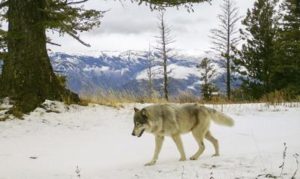Action Alert!! — Washington’s Wolves Need Your Voice
Deadline for Public Comment is November 15
The Washington Department of Fish and Wildlife is asking for your comments on how it should managed endangered gray wolves after they are “recovered” in the state.
WDFW background information and Scoping presentation slides presented at each of its three video conferences and printable PDFs of shareable information about wolf post-recovery planning for public distribution are available here:
Background and FAQ
Information postcard
Scoping comment form
All information about the wolf post-recovery planning process is available at wdfw.wa.gov/wolves-post-recovery.
What’s important to know about this issue?
- This is NOT a RECOVERY plan, this IS A WOLF DELISTING PLAN!! Washington wolves are currently listed as ENDANGERED – WDFW estimated there were only126 wolves in December, a 3% yearly growth rate.
- This is all about Politics – not science. Politicians bowing to pressure from the Livestock Industry, that is attempting to smother and confuse science and public opinion about wolf recovery.
- Wolves in Washington are NOT even close to being recovered. The State’s existing Wolf Conservation and Management Plan, page 64, #3, sets recovery objectives for “delisting” at 4 successfully breeding pair of wolves in each of the three recovery regions (Eastern WA, North Cascades, Southern Cascades) for three years and 3 successful breeding pairs anywhere else in the state.
- Only one region that currently meets the state’s delisting objectives – Eastern Washington.
- Washington’s current wolf population falls far short of a scientifically credible recovery level. Page 67 of the Wolf Plan notes “there is little empirical data from wolves in Washington to include in population persistence modeling.”
- WDFW is relying on inappropriate data from other states to support delisting wolves. Of those states, Montana, Idaho and Wyoming has about 1500 wolves; Minnesota, Wisconsin and Michigan has about 4,000. Washington’s wolf population is 126.
- Public Opinion is against it! The WDFW Wolf Conservation and Management Plan cites four public opinion and attitude surveys conducted in Washington from 2007 to 2009. All reported overwhelming support for the presence of wolves, including the most recent, which noted; “Among respondents living in eastern Washington, most preferred a situation in which wolves become reestablished in many, most, or all eastern Washington counties (68.4%) vs. in no or fewer eastern Washington counties (27.8%).”
Please send in your comments:
Make them personal as best you can. You can use some of the information above or below.
Tell the Department how you feel personally about this delisting gray wolves. Delisting has been shown to lead to more wolf killing.
Tell the Department you do NOT want Washington’s wolves delisted and that it’s inappropriate for the Department to pretend a state-listed endangered species that is not close to meeting state recovery objectives is in any way at a sustainable population levels.
What is clear is the Department is bowing to pressure from a small group of special interests who hate wolves. In 2014, WDFW proposed moving wolf management into their Game Management Plan that guides huntable game species.
This is little more than a slight of hand trickery. Not only is the gray wolf an endangered species, it is a family structured animal. Wolves are successful hunter only 5 to 10 percent of the time – wolves survive by living family groups. Even the loss of one member of a wolf family can send the entire family into disarray.
Wolves are not like deer, elk or other hunt-able species. They should not be listed with other hunted species. Even more stunning, Department of Fish & Wildlife include in their online survey for the 2015-2017 hunting regulations a category for wolves!
Evidence clearly shows livestock and wolves can coexist – but can humans learn to live in harmony with wolves? Wolf and livestock conflicts have predominately occurred on public lands and in situations where livestock were not observable and essential indefensible.
Deadline for comments is November 15. Send your comments to:
Online: https://wdfw.wa.gov/species-habitats/at-risk/species-recovery/gray-wolf/post-recovery-planning
By Mail:
Lisa Wood SEPA/NEPA Coordinator
WDFW Habitat Program
Protection Division
P.O. Box 43200, Olympia, WA 98504-3200
